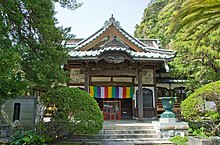An'yō-in (Kamakura)
| Gionzan An’yō-in Chōraku-ji | |
|---|---|

An'yō-in, Kamakura. The Main Hall
|
|
| Basic information | |
| Location | Ōmachi 3-1-22, 248-0007 Kamakura |
| Affiliation | Jōdo |
| Country | Japan |
| Website | None |
| Architectural description | |
| Founder | Hōjō Masako |
| Completed | 1225 |
Gionzan An’yō-in Chōraku-ji (祇園山安養院長楽寺?) is a Jōdo shū Buddhist temple in Kamakura, Kanagawa, Japan. Famous for its rhododendrons, it was named after its founder's (great historical figure Hōjō Masako) posthumous name. The main object of worship is Amida Nyorai, but it also enshrines Senju Kannon, Goddess of Mercy. An’yō-in is Number three of the 33 temples of the Bandō Sanjūsankasho pilgrimage circuit.
This temple has a complex history and is the result of the fusion of three separate temples called Chōraku-ji, Zendō-ji and Tashiro-ji. It was first opened in 1225 as Chōraku-ji in Hase Sasamegayatsu by Hōjō Masako for her defunct husband Minamoto no Yoritomo, founder of the Kamakura shogunate. At the time it was a Ritsu sect temple. After being burned to the ground by Nitta Yoshisada's soldiery in 1333 at the fall of the Kamakura shogunate, it was fused with Zendō-ji, moved to this spot and renamed, but it burned again in 1680. It was then once more rebuilt and a Senju Kannon (Thousand-armed Goddess of Mercy) was transferred to it from Tashiro-ji in Hikigayatsu.
The great Chinese black pine in the garden is over 700 years old. Behind the temple there are two hōkyōintō. The smallest is one of Masako's possible graves. The other is the oldest hōkyōintō in Kamakura and a nationally designated Important Cultural Property. In the temple's small cemetery down the alley in front of the temple's gate rests famous film director Akira Kurosawa.
...
Wikipedia
